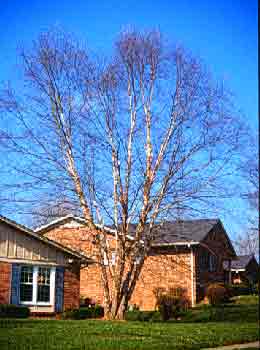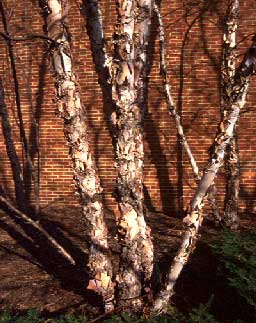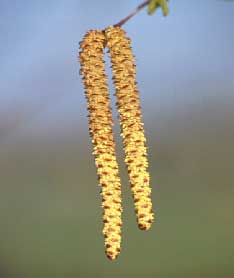 River Birch - Betula nigra
River Birch - Betula nigra
Birch Family (Betulaceae)
River birch occurs frequently along stream banks throughout Kentucky, except in the Bluegrass region. The Kentucky champion tree is in Johnson County and is 80 feet tall.
- Native habitat: Massachusetts to Florida, west to Minnesota, Kansas and Eastern Texas. River birch is found by large rivers of the coastal plain.
- Growth habit: Pyramidal when young, oval at maturity with an irregular crown. It forms several forks from the base, and each trunk leans outward.
 Tree size: 40 to 70 feet tall, although it can reach 90 feet, with a 40- to 60-foot spread. Growth rate is medium to fast, averaging 30 to 40 feet over 20 years. It is short-lived in urban areas, lasting 30 to 40 years. It lives longer when planted in moist areas.
Tree size: 40 to 70 feet tall, although it can reach 90 feet, with a 40- to 60-foot spread. Growth rate is medium to fast, averaging 30 to 40 feet over 20 years. It is short-lived in urban areas, lasting 30 to 40 years. It lives longer when planted in moist areas.- Flower and fruit: Male flowers are 2- to 3-inch-long, slender, dark brown catkins that are clustered and drooping. Female flowers are 1/3-inch-long catkins with bright green scales. Fruit is a small nutlet in a 1- to 1½-inch-long pendulous catkin. Fruit ripens in spring.
- Leaf: Alternate, simple, 2 to 4 inches long and 3/4 to 2½ inches wide. Medium to dark green in summer, leaves turn yellow in fall, when they drop quickly.
- Hardiness: Winter hardy to USDA Zone 4.
- ‘Cully' - Broadly pyramidal, with lighter bark than the species and large, glossy green leaves. Has good resistance to bronze birch borer.
- ‘Heritage' - Heat-loving, highly adaptive cultivar that won a Pennsylvania Horticulture Society Gold Medal in 1990. Its bark is whiter than any birch resistant to bronze birch borer. ‘Heritage' is better than river birch seedlings produced by cuttings and tissue culture, and has been shown to outgrow the seedlings by 50 percent. It has larger, glossier leaves, is hardy to at least -40 degrees F, and is able to adapt to the heat of the deep South.
 Additional information: River birch wood is hard, strong and knotty. Ox yokes, wooden shoes and furniture have been made from its wood. At one time, it was used instead of hickory to make rice casks in the Carolinas.
Additional information: River birch wood is hard, strong and knotty. Ox yokes, wooden shoes and furniture have been made from its wood. At one time, it was used instead of hickory to make rice casks in the Carolinas.
River birch was first cultivated in 1736. Although it tends to be a medium-sized tree, one tree in Alabama has grown to 111 feet tall, with a diameter of more than 4 feet. River birch can be used as a screen or shade tree, and as a street tree with irrigation. River birches are attractive when planted in groups, especially against a dark background.
River birch seed ripens in May and June. The ripening of seed coincides with high water levels of rivers, its native setting, allowing the seed to be carried long distances by the water. River birch seed germinates quickly in mud, allowing it to grow in areas where it helps prevent erosion. Thanks to its shallow root system, river birch is easy to transplant. It should be pruned in summer because it bleeds if pruned in spring.



